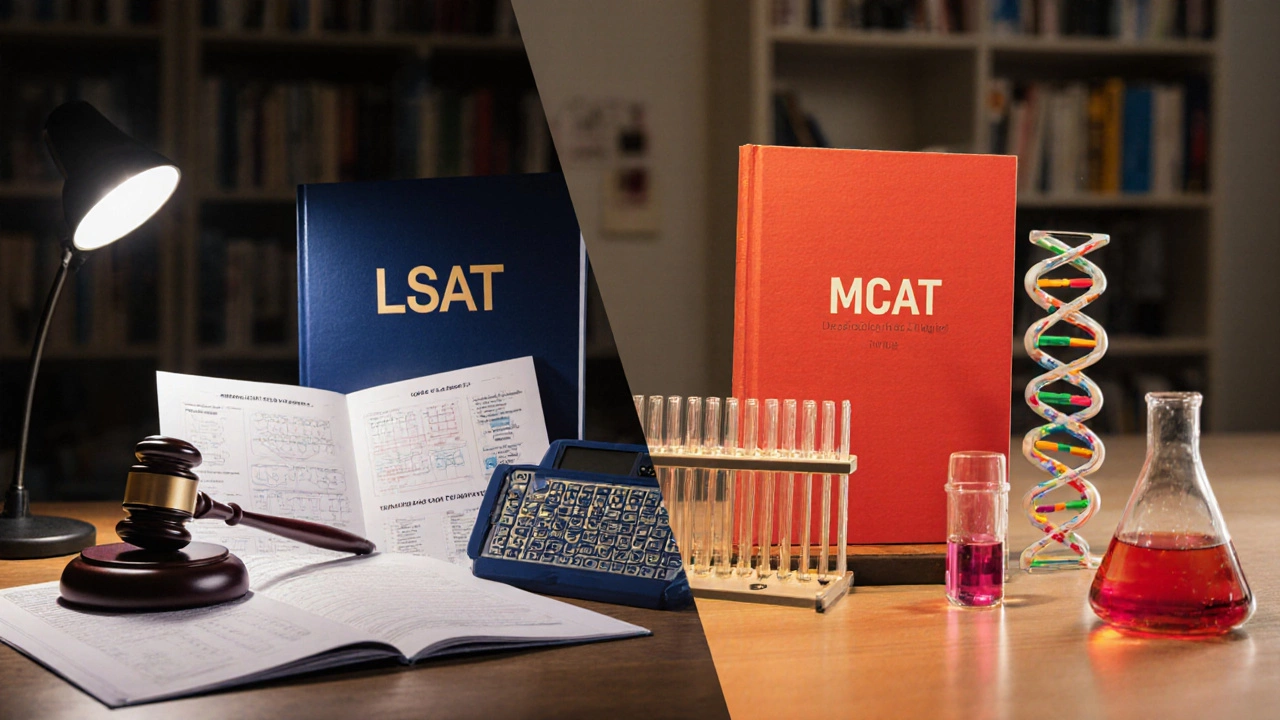LSAT vs MCAT Difficulty Comparator
This tool helps you assess which exam might feel harder based on your academic strengths and study preferences. Answer the following questions honestly to get personalized insights.
LSAT
Focuses on logical reasoning, analytical reasoning, and reading comprehension. Requires strong abstract thinking and pattern recognition.
Medium-High DifficultyMCAT
Tests in-depth science knowledge across biology, chemistry, physics, and psychology. Demands extensive memorization and application of concepts.
High DifficultyYour Personalized Assessment
Key Takeaways
- The LSAT leans heavily on logical reasoning and argument analysis; the MCAT demands deep science knowledge and interdisciplinary thinking.
- Prep time for the LSAT usually ranges from 150-200 hours, while the MCAT often requires 300-350 hours.
- Score ranges differ: LSAT scores run 120‑180, MCAT scores 472‑528; both use scaled scores, but the MCAT’s multi‑section format spreads difficulty across subjects.
- Students with strong math‑oriented backgrounds may find LSAT easier, whereas those with solid science coursework usually prefer the MCAT.
- Choosing which test feels harder depends on your academic strengths, study habits, and career goals.
When you start comparing the two biggest entrance exams, LSAT is a law school admission test that focuses on logical reasoning, analytical reasoning, and reading comprehension and the MCAT is a medical college admission test that evaluates biological, chemical, physical, and social scientific knowledge. Both are gate‑keepers for high‑stakes professional programs, but they measure very different skill sets.
What the LSAT Looks Like
The LSAT, administered by the Law School Admission Council (LSAC), is a four‑hour, six‑section exam (including an unscored variable section). Its core sections are:
- Logical Reasoning - 35 questions per section that test the ability to evaluate arguments.
- Analytical Reasoning ("Logic Games") - puzzles that require you to deduce relationships.
- Reading Comprehension - dense passages followed by detail‑oriented questions.
Scoring is on a 120‑180 scale, with each correct answer adding roughly one point. There is no penalty for guessing.
What the MCAT Looks Like
The MCAT, overseen by the Association of American Medical Colleges (AAMC), runs for 7 hours and 15 minutes, covering four sections:
- Biological and Biochemical Foundations of Living Systems - 59 questions.
- Chemical and Physical Foundations of Biological Systems - 59 questions.
- Psychological, Social, and Biological Foundations of Behavior - 59 questions.
- Critical Analysis and Reasoning Skills (CARS) - 53 questions, similar in style to LSAT reading comprehension.
Scores are reported on a 472‑528 scale, with each section contributing 118 points.

Format & Timing: Direct Comparison
| Feature | LSAT | MCAT |
|---|---|---|
| Administered by | LSAC | AAMC |
| Total time | ~4hours | ~7hours15min |
| Number of sections | 6 (5 scored + 1 experimental) | 4 |
| Primary skills tested | Logical reasoning, analytical reasoning, reading comprehension | Biology, chemistry, physics, psychology, sociology, critical reading |
| Score range | 120‑180 | 472‑528 |
| Typical prep time | 150‑200hours | 300‑350hours |
Depth of Content: Where Difficulty Peaks
The LSAT’s toughest moments usually come from the Logic Games. Even if you’re a strong reader, the timed deduction of multiple variables can feel like a mental sprint. By contrast, the MCAT’s hardest spots are the science sections. They demand not only factual recall but also the ability to apply concepts to unfamiliar scenarios.
For example, a typical Biological Sciences question might ask you to interpret a metabolic pathway diagram under altered pH conditions - a blend of memorization and reasoning. The LSAT rarely asks you to recall specific facts; it wants you to *analyze* arguments.
Study Hours & Resource Investment
Because the LSAT’s content is narrower, many test‑takers can reach a competitive score with focused practice. Official LSAT prep books, one‑hour logic‑game drills, and a couple of months of full‑time study often suffice.
The MCAT, however, is a marathon. You’ll likely need a dedicated review of undergraduate‑level biology, general chemistry, organic chemistry, physics, and behavioral sciences. A typical prep plan includes a comprehensive content review (200hours), practice questions (100hours), and full‑length tests (50hours).
In terms of financial cost, LSAT prep courses average $600‑$1,200, while MCAT packages (including content review and practice exams) often exceed $2,000.
Scoring Nuances & What ‘Hard’ Means Numerically
Both exams use scaled scores, but the interpretation differs. On the LSAT, each point roughly translates to a 1‑point change in percentile rank, making a 164-166 score (top 10%) a solid target for most law schools. On the MCAT, a 510-514 (roughly 80‑85th percentile) is considered competitive for most MD programs.
Because the MCAT’s four sections each have their own challenges, a low score in one science section can be offset by a high CARS score, whereas the LSAT’s sections are more interdependent.
Which Test Feels Harder for Different Backgrounds?
STEM‑oriented students (engineering, biology, chemistry) often report the MCAT as the tougher hurdle, mainly because of the sheer volume of specific knowledge to master.
Non‑STEM students (humanities, social sciences) usually find the LSAT more demanding, especially the Logic Games, which require abstract pattern recognition.
If you’re a strong reader with an analytical mindset but limited lab experience, the LSAT’s CARS‑style reading will feel familiar, while the MCAT’s chemistry questions may feel like a steep climb.
Conversely, if you excel at memorizing formulas and interpreting data tables but struggle with dense argumentative prose, the MCAT’s science sections will be a breeze, and the LSAT’s reading will be the hurdle.
Decision Guide: How to Choose Your Focus
- Identify your career goal. Law school = LSAT, medical school = MCAT. No point trying to compare if you’re only applying to one.
- Assess your academic strengths. Rate yourself 1‑10 in logical reasoning, reading comprehension, biology, chemistry, physics, and psychology.
- Map prep time. If you can only dedicate 150hours, the LSAT is more realistic. If you have a year for intensive study, the MCAT becomes manageable.
- Try a diagnostic test. Free official LSAT and MCAT practice sections are available online. Your initial score will reveal which test feels naturally harder.
- Consider test‑day stamina. The MCAT’s 7‑hour stretch demands nutrition planning and endurance; the LSAT’s 4‑hour block is less taxing.
In the end, "harder" is personal. Use the above criteria to pinpoint which exam aligns with your strengths and timeline.
Frequently Asked Questions
Can I take both the LSAT and MCAT in the same year?
Yes, but it’s demanding. You’ll need a solid study schedule that separates the two subjects, ideally dedicating at least three months to each with a short break in between.
Which exam has a higher pass‑rate?
Both exams are pass/fail based on school admissions thresholds, not a universal passing score. However, the average LSAT score is around 152, while the average MCAT score hovers near 508. Success depends on the schools you target.
Do LSAT Logic Games require mathematics?
Not in the traditional sense. They involve logical deduction, set theory, and sequencing, but you won’t need algebra or calculus.
Is the MCAT CARS section similar to any LSAT part?
Yes, CARS mirrors LSAT Reading Comprehension. Both test your ability to parse dense prose and infer meaning without outside knowledge.
How many practice tests should I take?
Aim for at least three full‑length LSAT practice exams and four MCAT full exams. Space them out to simulate test‑day conditions and review each thoroughly.





